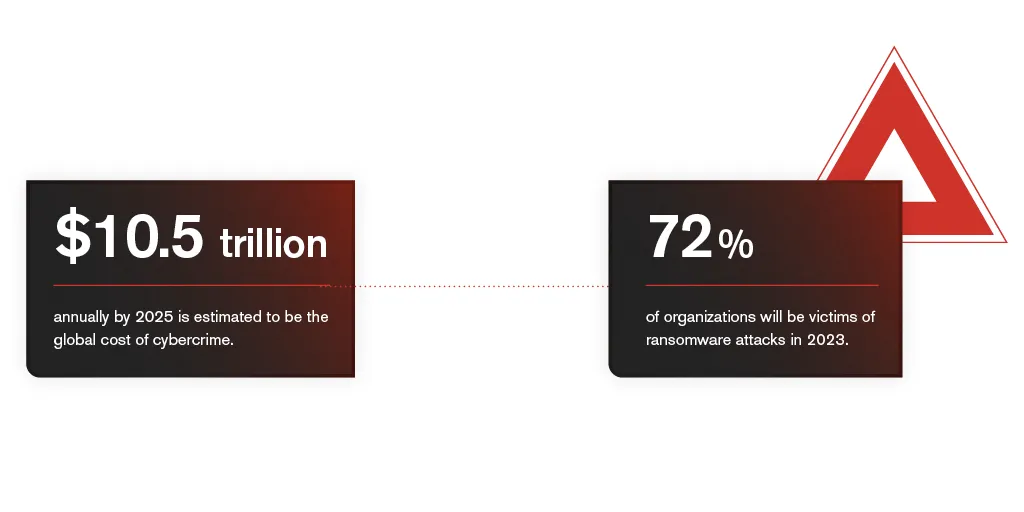It’s already nearly 2025! And, just as expected, the rate of cyber attacks and number of advanced threats is only going up.
As organizations integrate advanced technologies, new vulnerabilities are introduced. For CISOs, it is imperative to stay ahead of these threats and ensure that your organization is well-prepared to face the challenges of the future.
This blog will provide insights into current cybersecurity threats, make suggestions on steps you can use now to review your existing security measures, and provide guidance on technological trends that may impact your cybersecurity strategy in 2025.
Let’s start by examining the factors that are most influential right now in cybersecurity:
Widespread adoption of artificial intelligence and machine learning
The adoption of artificial intelligence (AI) and machine learning is the single most influential factor in the changes we are seeing. As of 2024, 72% of organizations have integrated AI into at least one business function, marking a significant increase from previous years. The AI market is projected to reach $1.3 trillion by 2030, up from an estimated $214 billion in 2024. Moreover, 64% of businesses believe that AI will help increase their overall productivity. These advancements enable more sophisticated threat detection and response mechanisms, but they also empower cybercriminals to launch more complex attacks.
Growing interconnectivity of devices through the Internet of Things
The proliferation of IoT devices is another critical factor reshaping cybersecurity. The number of connected IoT devices has grown by 13% in 2024, reaching 18.8 billion by the end of the year. By 2030, this number is projected to soar to 40 billion. This rapid expansion is driven by advancements in communication technologies such as 5G, which facilitate greater connectivity and data exchange. However, this also introduces new vulnerabilities, as each connected device can potentially serve as an entry point for cyber-attacks.
Escalating frequency and complexity of cyber attacks
Global cybercrime costs are estimated to hit $10.5 trillion annually by 2025, reflecting the increasing audacity and sophistication of these attacks. The frequency of state-sponsored cyber attacks is growing. Additionally, ransomware remains a pervasive threat, with 72% of organizations falling prey to such attacks in 2023.
These dynamics are reshaping our cybersecurity ecosystems, demanding enterprises deploy more robust and adaptive security strategies to protect against emerging threats. By understanding these trends and integrating advanced technologies into your cybersecurity strategy, you can better protect your organization against advanced threats.
It is also crucial that we understand as much as we can about the current cybersecurity threats facing companies today. They are more sophisticated and varied than ever before:
- Ransomware Attacks: Ransomware continues to be a pervasive threat, with attacks becoming more targeted and disruptive. High-profile incidents in 2024, such as the attacks on Change Healthcare and CDK Global, have highlighted the devastating impact ransomware can have on critical infrastructure and services.
- Supply Chain Vulnerabilities: The interconnected nature of modern supply chains means that a vulnerability in one link can compromise the entire chain. The exploitation of Ivanti VPNs by threat actors in early 2024 is a stark reminder of the risks associated with third-party services.
- Phishing and Social Engineering: Despite advancements in security technologies, phishing remains a highly effective attack vector. Cybercriminals are using increasingly sophisticated techniques to deceive employees and gain access to sensitive information.
- AI-Driven Attacks: The use of artificial intelligence (AI) by cybercriminals to automate and enhance their attacks is on the rise. AI can be used to identify vulnerabilities, craft convincing phishing emails, and even launch adaptive attacks that evolve in real time.
- Cloud Security Concerns: As organizations continue to migrate to the cloud, ensuring the security of cloud environments is paramount. Misconfigurations, inadequate access controls, and vulnerabilities in cloud services can expose organizations to significant risks.
Having reviewed the current threats and technology trends shaping cybersecurity, it’s crucial to turn our attention to evaluating whether your existing cybersecurity measures are prepared for the challenges of 2025.
Ensuring your cybersecurity measures are up to the task
To ensure your cybersecurity measures are fit for purpose, a comprehensive review of your current estate is essential. This involves assessing your current security posture, identifying potential gaps, and implementing necessary improvements to protect your organization against advanced threats.
- Conduct a Risk Assessment: Begin with a thorough risk assessment to identify potential threats and vulnerabilities. This involves evaluating the likelihood and impact of various cyber threats on your organization.
- Evaluate Existing Controls: Assess the effectiveness of your current security controls. This includes reviewing your firewall configurations, intrusion detection systems, endpoint protection, and access controls.
- Identify Gaps: Compare your current security posture against industry standards and best practices, such as the NIST Cybersecurity Framework (CSF) 2.0 and the MITRE Attack framework. This will help you identify any gaps in your security measures.
- Engage Stakeholders: Involve key stakeholders from across the organization in the review process. This ensures that all perspectives are considered and that there is a shared understanding of the cybersecurity risks and priorities.
- Develop a Remediation Plan: Based on the findings of your assessment, develop a remediation plan to address any identified gaps. Prioritize actions based on the level of risk and the potential impact on your organization.
- Consider New Technology Investments: Leverage the powerful synergy of threat intelligence driven by deception from platforms like CounterCraft. Their approach helps keep systems and data protected. Digital twin technology creates decoys and traps that mislead attackers, providing crucial alerts and threat intelligence to support your cybersecurity strategy.
Seeking advice and best practices
Staying informed about the latest cybersecurity trends and best practices is crucial. Here are some resources and strategies to consider:
- Industry Reports and Research: Reputable sources such as Gartner provide valuable insights into emerging cybersecurity trends and best practices. Gartner’s reports on the top cybersecurity trends for 2024 highlight the importance of generative AI, continuous threat exposure management, and identity-first security.
- Professional Networks and Forums: Engage with professional networks and forums to share knowledge and experiences with other cybersecurity professionals. Organizations such as ISACA and (ISC)² offer valuable resources and opportunities for networking.
- Consult with Experts: Consider engaging cybersecurity consultants to provide an external perspective on your security posture. They can offer specialized expertise and help you implement best practices tailored to your organization’s needs.
- Training and Awareness Programs: Invest in ongoing training and awareness programs for your employees. Human error remains a significant factor in many cybersecurity incidents, so educating your workforce is critical to reducing risk.
As we prepare for 2025, it is essential to adopt a proactive and comprehensive approach to cybersecurity. By understanding the current threats, reviewing and enhancing your security measures, staying informed about regulatory changes, and anticipating future trends, you can ensure that your organization is well-positioned to face the challenges ahead. Remember, a strong cybersecurity strategy is not just about finishing safe—it’s about starting strong.

